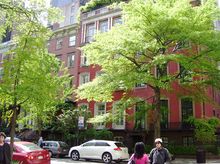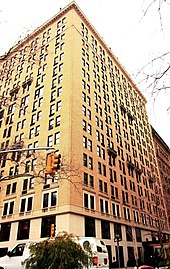Gramercy Park

Gramercy Park is the name of a neighborhood (also called "Gramercy" ) and a small, fenced private park in the New York borough of Manhattan in the United States .
The park
The Gramercy Park was a 1980 National Historic District in the National Register of Historic Places added. It is approximately 8,000 square meters and is one of two private parks in New York City that only residents who live next to the park and who pay an annual fee have access with a key. The park is generally not open to the general public, but the sidewalks around the park are very popular with joggers, walkers and dog owners.
With the Sunnyside Gardens in Queens, there is another private park in New York City. Here, too, the park is owned by the owners of the surrounding houses, which has been written down in Gramercy Park since December 31, 1831. Residents of the buildings directly on the park can buy a key to the park, which is changed once a year. In addition, members of the Players Club , the National Arts Club , guests of the Gramercy Park Hotel and Calvary Church have a key to the park.
Gramercy Park is bounded to the north and south by East 21st Street , which is called Gramercy Park North on Park , and East 20th Street , which is called Gramercy Park South on Park . To the west and east, the park is bordered by two cross streets, Gramercy Park West and East , which are located between Park Avenue South and Third Avenue .
The Irving Place ends at the south side of Gramercy Park. Lexington Avenue , an important north-south traffic axis on the east side of Manhattan, begins on the opposite north side.
The quarter

The park forms the middle of the district of Gramercy or Gramercy Park and the Gramercy Park Historic District . The Gramercy Park area is administratively located on Manhattan Community Board 5 and Manhattan Community Board 6 and is considered a quiet and safe residential area. The neighborhood is roughly bounded by 14th Street to the south, First Avenue to the east, 23rd Street to the north, and Park Avenue South to the west. To the west of Gramercy Park are Flatiron District and Union Square , to the south are Greenwich Village and the East Village , to the east are Stuyvesant Town and Peter Cooper Village , to the northwest are Rose Hill and to the northeast are Kips Bay .
When the New York City Landmarks Preservation Commission established the Gramercy Park Historic District in 1966, they relied on John B. Pine's book "The Story of Gramercy Park," according to which Gramercy Park was one of the first urban planning approaches in the country. The Gramercy Park Historic District is located within the Gramercy Park district and was expanded in 1988 (see info box). A proposed expansion would include an additional 40 buildings to the east and north of Gramercy Park on Lexington Avenue, Park Avenue South, East 22nd Street , East 19th Street, and Irving Place.
While the real estate market in Manhattan is constantly changing, the area around Gramercy Park is one of continuity. The street between East 19th Street and Third Avenue and Irving Place is called “Block Beautiful” because of its versatile architecture and beautiful townhouses with spacious backyards and smaller apartments.
The Gramercy Park Hotel was built in 1925 by the Bing brothers based on a design by Robert T. Lions . In 1926, Humphrey Bogart and Helen Menken married here . In 2006 the hotel was completely overhauled by hotelier Ian Schrager in collaboration with artist Julian Schnabel . The hotel overlooks the park and guests receive a key to Gramercy Park with the room key.
history
The area around Gramercy Park was originally a swamp and was proposed in 1831 by Samuel B. Ruggles for the construction of a park as part of the expansion of Manhattan to the north. Ruggles acquired the land, then a farm called "Gramercy Farm" by James Duane , a descendant of Peter Stuyvesant . To make the land arable, Ruggles invested $ 180,000. The swamp was drained and about a million horse carts full of earth had to be moved. He then created a site plan "Gramercy Square" and transferred ownership of the square to the owners of the 60 properties that he had designated in the area around the square. At the same time he achieved that in 1832 the Board of Aldermen exempted the park from taxation.
Gramercy Park was the second private park in New York after Hudson Square (also known as St. John's Park), which was created by the Trinity Church parish. It was fenced in in 1833, although construction on the surrounding lots did not begin until the 1840s. The park was first planted in 1844.
In 1863, Gramercy Park served as a camp for the soldiers of the Northern States who were supposed to put down the draft riots (draft riots). These riots broke out in New York after the introduction of compulsory military service, which the upper class could buy their way out by paying $ 300. Other soldiers bivouacked in nearby Stuyvesant Square .
In 1890 and 1912 a cable tram was wanted to run through the park to connect Irving Place and Lexington Avenue, but both times this was not realized.
At the end of the 19th century, numerous influential aid organizations settled on 23rd Street, some of which are still here today - such as the Federation of Protestant Welfare Agencies . The Calvary Church on Gramercy Park North maintains a Tafelladen that every week is open again for an hour. Before the Civil War (1861–1865), the Brotherhood Synagogue on Gramercy Park South was a meeting place for the Quakers (since 1859) and part of the Underground Railroad , which helped slaves escape to the Northern States.
In 1983 the 4.5 ton sculpture "Fantasy Fountain" by artist Greg Wyatt was installed in the park. In 1989, an underground steam pipe exploded near Gramercy Park. Two Consolidated Edison employees and a passerby were killed and millions of dollars in damage to surrounding buildings were caused.
Once a year, on Gramercy Day, the park was open to the public, usually on the first Saturday in May. In 2007, however, it was announced that the park will no longer be open in the future.
See also
- List of Manhattan neighborhoods
- East Village
- Flatiron District
- Madison Square
- Murray Hill
- Union Square
literature
- Brooks, Gladys (1958): Gramercy Park: Memories of a New York Girlhood , New York: Dutton
- Garmey, Stephen (1984): Gramercy Park: An Illustrated History of a New York Neighborhood . ISBN 0-917439-00-7 .
- Klein, Carole (1987): Gramercy Park: An American Bloomsbury , New York: Houghton Mifflin
- Pine, John B (1921): The Story of Gramercy Park
Web links
- Gramercy Park in NYC Insider: an Insider's Guide to New York City (English)
- The Gramercy Park Historic District and its extension - map on nyc.gov (English; PDF; 204 kB)
- Proposed expansion of the Gramercy Park Historic District on Gramercy Neighborhood Associates website
- Gramercy Park on Citysearch NYC (English)
- History of the Gramercy Park Hotel (English)
Coordinates: 40 ° 44 ′ 16.6 ″ N , 73 ° 59 ′ 9.2 ″ W.




